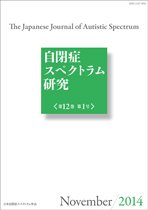Volume 12, Issue 1
Displaying 1-10 of 10 articles from this issue
- |<
- <
- 1
- >
- >|
-
2014 Volume 12 Issue 1 Pages 1
Published: November 30, 2014
Released on J-STAGE: April 25, 2019
Download PDF (496K)
-
2014 Volume 12 Issue 1 Pages 5-17
Published: November 30, 2014
Released on J-STAGE: April 25, 2019
Download PDF (1583K) -
2014 Volume 12 Issue 1 Pages 19-28
Published: November 30, 2014
Released on J-STAGE: April 25, 2019
Download PDF (965K)
-
2014 Volume 12 Issue 1 Pages 29-39
Published: November 30, 2014
Released on J-STAGE: April 25, 2019
Download PDF (1285K)
-
2014 Volume 12 Issue 1 Pages 41-46
Published: November 30, 2014
Released on J-STAGE: April 25, 2019
Download PDF (841K)
-
2014 Volume 12 Issue 1 Pages 47-53
Published: November 30, 2014
Released on J-STAGE: April 25, 2019
Download PDF (748K) -
2014 Volume 12 Issue 1 Pages 55-64
Published: November 30, 2014
Released on J-STAGE: April 25, 2019
Download PDF (915K)
-
2014 Volume 12 Issue 1 Pages 65-72
Published: November 30, 2014
Released on J-STAGE: April 25, 2019
Download PDF (936K)
-
2014 Volume 12 Issue 1 Pages 73-79
Published: November 30, 2014
Released on J-STAGE: April 25, 2019
Download PDF (1468K)
-
2014 Volume 12 Issue 1 Pages 95
Published: November 30, 2014
Released on J-STAGE: April 25, 2019
Download PDF (447K)
- |<
- <
- 1
- >
- >|
